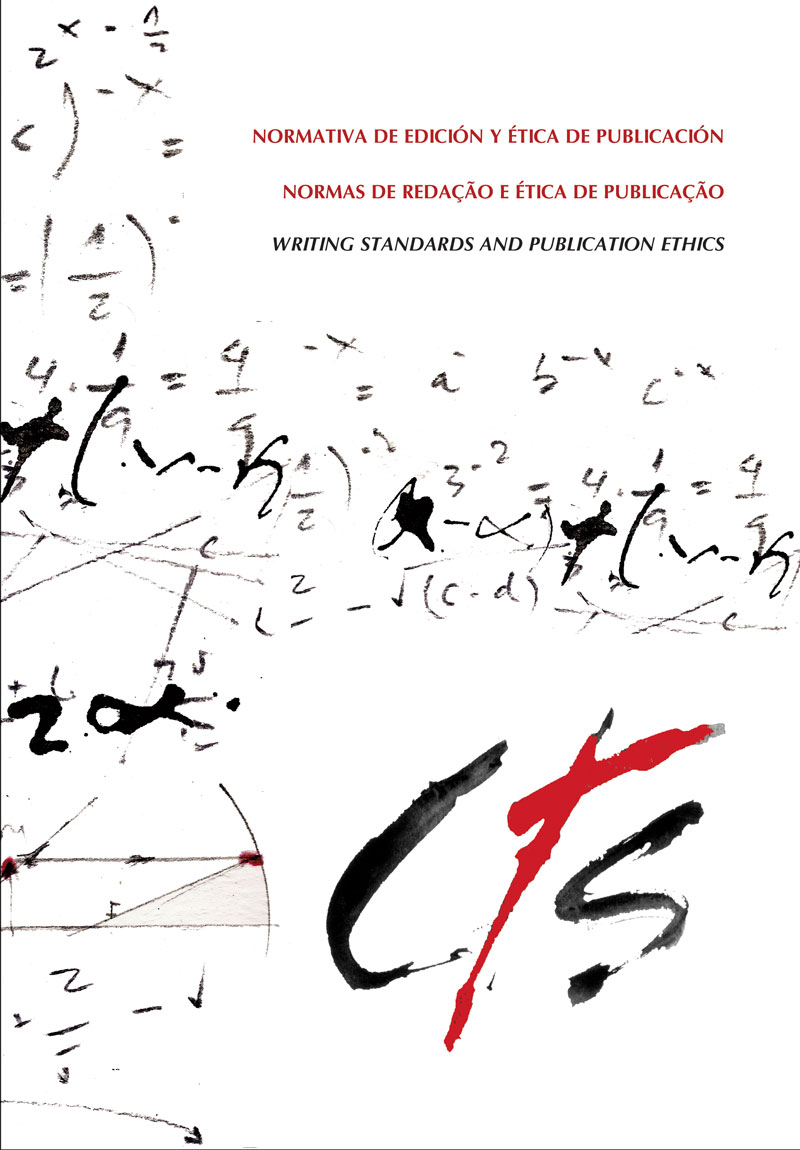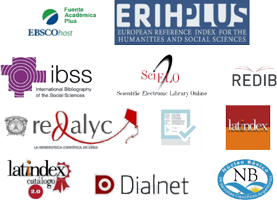Analysis of the Presence, Quality and Documentary Performance of Hypertext in the Covid-19 Coverage on "Muy Interesante" Magazineʼs Website
Keywords:
hypertext, link, scientific communication, scientific journalism, new technologiesAbstract
This article analyzes the hypertext in the Covid-19 coverage on the Muy Interesante magazine website (www.muyinteresante. es), which is one of the most widely read scientific communication magazines in Spain and also during this epidemiological outbreak. Its objectives are to research whether hypertext is used in the construction of the informative message, to identify the provenance of the links (internal or external), to assess the quality of the hypertext, to identify the typologies of the external links, and to describe the different morphologies that make up each typology. Every hypertext (n = 1,626) of the articles published in the “Coronavirus” section (n = 204) of the website between the 7th of February and 14th of May, 2020, is analyzed. Content analysis was chosen for this endeavor and the identification codes of the variables were established beforehand. The results show the high representation of hyperlinks, significant quality of the hypertext, preference for using internal instead of external links, and that the external links identified are methodological-scientific, organizational or curricular hypertexts, with those showing the original source being the most used. To conclude, a first approximation of the hypertext usage frameworks for fostering digital competence in Internet scientific communication can begin to be established.Downloads
References
ARIAS-ROBLES, F. y GARCÍA-AVILÉS, J. A. (2018): “El destino del enlace periodístico: percepción de los editores y aplicación práctica de la hipertextualidad en los medios españoles”, Palabra clave, vol. 21, nº 2, pp. 275-309.
ARMENTIA, J. I., CAMINOS, J. M., ELEXGARAY, J., MARÍN, F. y MERCHÁN, I. (2000a): El Diario Digital. Análisis de los contenidos textuales, aspectos formales y publicitarios. Barcelona, Bosch.
ARMENTIA, J. I., CAMINOS, J. M., ELEXGARAY, J. y MERCHÁN, J. (2000b): “La información en la prensa digital: redacción, diseño y hábitos de lectura”, Zer: Revista de estudios de comunicación, vol. 5, nº 8, pp. 183-212.
BARREDO, D. (2013): “Fuentes de información y enlaces hipertextuales en las alusiones al rey Juan Carlos en El País y ABC.es (2009- 2011)”, Comunicación y Hombre, nº 9, pp. 89-113.
BARBOSA, F., MONTEIRO, l. y SILVA, R. (2018): “Folksonomia: análise de etiquetagem de imagens da National Geographic Brasil no Instagram”, Informação & Informação, vol. 23, nº 3, pp. 342-361.
BELLÓN, A. (2016): “La labor en soporte papel y online de suplementos y revistas en la divulgación de la I+D+i en España. Dos casos de estudio: Tercer Milenio y Quo”, Razón y Palabra, nº 20, pp. 439-461.
BERNARDINO, J. y CEBRIÁN, E. (2017): “Función y valor documental de los enlaces semánticos en la prensa española (2002-2016)”, Miguel Hernández Communication Journal, nº 8, pp. 489-519.
BEYERS, H. (2006): “What constitutes a good online news site? A comparative analysis of American and European awards”, Communications, vol. 31, nº 2.
BOLUFER, I. (2016): “Las revistas de divulgación científica españolas en la era digital: Los casos de Muy Interesante, Quo y Materia”. Disponible en: http://repositori.uji.es/xmlui/handle/10234/163878. Consultado el 10 de mayo de 2020.
BRICIO, A. (2016): “Las revistas científicas digitales: mensajes divulgativos y aprovechamiento de los recursos”. Disponible en http://riull.ull.es/xmlui/handle/915/3583. Consultado el 10 de mayo de 2020.
BROSSARD, D. y SCHEUFELE, D. (2013): “Science, new media and the public”, Science, vol. 339, nº 6115, pp. 40-41.
CASTELLANOS, J. (2011): “De lo impreso a lo digital. La migración de los periódicos impresos de América latina a los entornos digitales”, Razón y Palabra, nº 77.
CODDINGTON, M. (2012): “Building Frames Link by Link: The Linking Practices of Blogs and News Sites”, International Journal of Communication, nº 6, pp. 2007–2026.
DE MAEYER, J. (2012): “Liens Hypertextes et Journalisme: Une Archéologie des Discours Méta-journalistiques”. Disponible en: https://bit.ly/3fb3f3. Consultado el 5 de junio de 2020.
DE MAEYER, J. (2013): “Dérouler le fil des liens hypertexTes: les controverses au service de l’imagiNaire Journalistique”, Recherches en communication, nº 40, pp. 117-132.
DE VICENTE, A. M (2016): “Ediciones digitales de las revistas de divulgación científicas editadas en España: orígenes e inicio”, en F. Sabes y J. Verón (coords.): La comunicación del presente: Mas allá de las pantallas, Aragón, Asociación de periodistas de Aragón, pp. 6-12.
DE VICENTE, A. M. (2017): “Estrategias de comunicación digital de las revistas de divulgación científica editadas en España”, en J. Sierra y M. Cadaval (coords.): En el punto de mira: investigaciones sobre comunicación en la era digital, Madrid, McGraw-Hill Interamericana, pp. 117-124.
DE VICENTE, A. M (2019). “Estrategia de comunicación digital de la revista Viajes National Geographic en Instagram”, en J. Sierra y J.M. Lavín (coords.): Redes sociales, tecnologías digitales y narrativas interactivas en la sociedad de la información, Madrid, McGraw-Hill Interamericana, pp. 89-98.
DE VICENTE, A. M y CEA, N. (2019): “El hipertexto en la divulgación científica: análisis de su uso en el perfil de twitter @materia_ciencia de El País como caso objeto de estudio”, Hipertext.net, nº 19, pp. 85-92.
DEUZE, M. (2003): “The web and its journalisms: considering the consequences of different types of newsmedia online”, New Media & Society, vol. 5, nº 2, pp. 203-229.
DIMITROVA, D. V., CONNOLLY-AHERN, C., WILLIAMS, A. P., KAID, L. L. y REID, A. (2003): “Hyperlinking as gatekeeping: Online newspaper coverage of the execution of an American Terrorist”, Journalism Studies, vol. 4, nº 3, pp. 401-414.
DIMITROVA, D. y NEZNANSKI, J. (2006). “Online Journalism and theWar in Cyberspace:A Comparison Between U.S. and International Newspapers”, Journal of Computer-Mediated Communication, vol. 12, pp. 248–263.
ENGEBRETSEN, M. (2013): “Hypernews and Coherence”, Nordicom Review, vol. 21, nº 2, pp. 209-225.
FONDEVILA, J. F. y SEGURA, H. (2012): “La hipertextualidad en el periodismo digital en Colombia”, Hipertext.net, nº 10. Disponible en https://www.upf.edu/hipertextnet/numero-10/hipertextualidad-periodismo-digital-colombia.html.
FONDEVILA, J., BERIAIN, A., PERELLÓ, M. y BARBERO, V. (2014): “Estudio de caso de prensa digital internacional: hipertextualidad, multimedia e interactividad en USA Today, Le Monde, The Telegraph y Clarín”, en R. Colle, F. Campos, J. F. Fondevila, J. Bustos y J. Novoa (coords.): Estudios sobre la prensa digital iberoamericana, Alicante, Colección Mundo Digital de la Revista Mediterránea de Comunicación, pp. 58-69.
FONDEVILA, J. F., BERIAIN, A., DEL OLMO, J. L y CARLES, J. (2014): “Interactividad, multimedia e hipertextualidad en el periodismo digital deportivo en España”, en A.R Fernández (coord.): Interactividad y redes sociales, Madrid, ACCI, pp. 231-244.
FONDEVILA J. F., ROM, J. y SANTANA, E. (2016): “Comparativa internacional del uso de recursos digitales en el periodismo digital deportivo: estudio de caso de España y Francia”, Revista Latina de Comunicación Social, nº 71, pp. 124-140.
FONDEVILA, J. F. (2014): “El uso del Hipertexto. Multimedia e interactividad en periodismo digital: propuesta metodológica de ranking de calidad”, Zer, vol. 19, nº 36, pp. 55-76.
FREIXA, P., PÉREZ-MONTORO, M. y CODINA, L. (2017): “Interacción y visualización de datos en el periodismo estructurado”, El profesional de la información, vol. 26, nº 6, pp. 1076-1090.
GARCÍA, M. A., ARÉVALO M. A. y HERNÁNDEZ, C. A. (2019): “Estrategia de comprensión lectora: una propuesta para la lectura de los hipertextos”, Saber, ciencia y libertad, vol. 14, nº1, pp. 287-310.
HALL, J. (2001): Online Journalism: A Critical Primer, Londres, Pluto.
LLANO, S. (2005): “Hipermedia e interactividad: teoría y práctica en los periódicos digitales colombianos”, Palabra clave, nº 12, pp. 114-127.
LARSSON, A. O. (2012): “Staying In or Going Out? Assessing the Linking Practices of Swedish online newspapers”, Journalism Practice, vol. 7, nº 6, pp. 738-754.
LARRONDO-URETA, A. y DÍAZ-NOCI, J. (2014): “Hypertextual structure of online news: A comparative research on quality media”, en A. Larrondo., K. Meso y A. Tous (coords.): Shaping the news online. A comparative research on international quality, Covilhã, LabCom, pp. 249-300.
LARRONDO, A. (2009a): El reportaje hipermedia. Análisis del género en los especiales de elmundo.es, elpais.com y lavanguardia.es, Servicio Editorial Universidad del País Vasco.
LARRONDO, A. (2009b): “La metamorfosis del reportaje en el ciberperiodismo: concepto y caracterización de un nuevo modelo narrativo”, Comunicación y Sociedad, vol. XXII, nº 2, pp. 59 -88.
LARRONDO, A. (2010): “Propuesta metodológica para una aproximación empírica a los géneros ciberperiodísticos”, Zer, vol. 15, nº 28, pp. 157-174.
LARRONDO, A. (2011): “The potencial of web-only feature stories. A case of Spanish media sites”, Journalism Studies, vol. 12, nº 2, pp. 188-204.
LÁZARO-RODRÍGUEZ, P. y HERRERA-VIEDMA, E. (2020): “Noticias sobre COVID-19 y 2019-nCoV en medios de comunicación de España: el papel de los medios digitales en tiempos de confinamiento”, El profesional de la información, vol. 29, nº 3, pp. 1-11.
LÓPEZ, X., PEREIRA, J. y GAGO, M. (2001): “¿Llegó la hora del “lecto-periodista? Análisis de la utilización de enlaces externos en Gaceta de Galicia”, Estudios del mensaje periodístico, nº 7, pp. 109-111.
LÓPEZ-PÉREZ, L. y OLVERA-LOBO, M. D. (2015) “Tratamiento de la información científica en las ediciones digitales de los periódicos españoles”, El profesional de la información, vol. 24, nº 6, pp. 766-777.
MCADAMS, M. Y BERGER, S. (2001): “Hypertex”, Journal of Electronic Publishing, vol. 6, nº3.
MUY INTERESANTE (1999): “Muy Digital: la Web para saber más”, Muy Interesante, nº 216, pp. 236-238.
NEGRI, I. (2010): “El periodista digital como artesano de la información”, en F. Irigaray, D. Ceballos y M. Manna (eds.): Periodismo Digital en un paradigma de transición, Universidad Nacional del Rosario, Fundación La Capital, pp. 46-52.
OBLACK, T. (2005): “The lack of interactivity and hipertextuality in online media”, The International Journal of Communication Studies, vol. 67, nº 1, pp. 87-106.
OPGENHAFFEN, M. (2011): “Multimedia, interactive and hypertextual features in divergent online news platforms: An exploratory study of Flemish online news”, First Monday, vol. 16, nº 3. Disponible en: https://journals.uic.edu/ojs/index.php/fm/article/view/2826/2814. Consultado el 10/04/2020.
OPHIR, Y. (2020): “Los medios de comunicación fallan a la hora de informar sobre epidemias”. Disponible en: https://theconversation.com/los-medios-de-comunicacion-fallan-a-la-hora-de-informar-sobre-epidemias-101845. Consultado el 10/07/2020.
ORERO, P. (2016): “Uso y valor documental del hipertexto en la prensa española (2002-2016)”, tesis doctoral, Valencia, Universidad Ceu Cardenal Herrera.
ORERO, P., BERNANDINO, J. y CEBRIAN, J. (2019): “Evolución del uso del hipertexto en la prensa española (2002- 2016)”, El profesional de la información, vol. 28, nº 2.
PALERMO, A. (2016): “The impact of the scientific cyberjournalism on Facebook: cases Focus and Muy Interesante”, en A. Ureta, K. Meso Ayerdi y S. Peña (coords.): VIII Congreso Internacional de Ciberperiodismo: el impacto de las audiencias en los perfiles profesionales y los contenidos, Universidad del País Vasco, pp. 314-324.
PÉREZ MARCO, S. (2003): “El concepto de hipertexto en el periodismo digital: análisis de la aplicación del hipertexto en la estructuración de las noticias de las ediciones digitales de tres periódicos españoles (www.elpais.es, www.elmundo.es, www.abc.es)”, tesis doctoral, Madrid, Universidad Complutense de Madrid.
PÉREZ TORNERO, J. M. y TEJEDOR, S. (2014): Escribir para la red. Reflexiones sobre la nueva (y vieja) escritura informativa “online”, Universidad de Barcelona.
PILLAI, A. (2019): “Image vs. text in narratives: The case study of National Geographic’s Instagram”. Disponible en: https://bit.ly/2KtMHZH. Consultado el 02/06/2020.
QUANDT, T. (2008): “(No) News on the World Wide Web? A comparative content analysis of journalistic news sites in four European countries”, Thinking Journalism Across National Boundaries, Monreal.
ROST, A. (2003): “Una propuesta metodológica para estudiar el hipertexto en el periódico digital”, Anàlisi: Quaderns de comunicació i cultura, nº 30, pp. 169-183.
ROST, A. (2012): “The concept of hypertext in digital journalism”, IAMCR Barcelona. Disponible en: https://bit.ly/38RrbIs Consultado el 12/06/2020.
RUBIO, M. y BLANCO, J. C. (2010): “Mejor que un buscador, un encontrador”. Documentación de las Ciencias de la Información, vol. 33, nº 27, pp. 273-287.
SAEMMER, A. (2012): “Etude sémio-rhétorique du rôle de l’hypertexte dans le discours journalistique”, Mediation et Information, vol. 34, nº 10, pp. 133-144.
SALAVERRÍA, R. (1999): “De la pirámide invertida al hipertexto: hacia nuevos estándares de redacción para la prensa digital”, Novatica, nº 142, pp. 12-15.
SALAVERRÍA, R. (2005): Redacción periodística en internet, Barañáin, Eunsa.
SIRE, G. (2017): “Tout ça pour ça? Titres fonctionnels et égocentrisme hypertexte. Le Web dans les rédactions de presse écrite”. Disponible en: https://hal.archives-ouvertes.fr/hal-02433567. Consultado el 05/02/2020.
STEENSEN, S. (2011): “Online journalism and the promises of new”, Journalism Studies, vol. 12, nº 3, pp. 311-327.
TREMAYNE, M. (2005): “News Websites as Gated cibercommunities”, Convergence, vol. 11, nº 3, pp. 28-39.
TREMAYNE, M. (2006): “Applying network theory to the use of external links on news web sites”, en L. Xigen (ed.): Internet newspapers: The making of a mainstream medium, Oxford, Routledge, pp. 49-64.
VOBIČ, I. (2014): “Practice of Hypertext”, Journalism Practice, vol. 8, nº 4, pp. 357-372.
Downloads
Published
How to Cite
Issue
Section
License
All CTS's issues and academic articles are under a CC-BY license.
Since 2007, CTS has provided open and free access to all its contents, including the complete archive of its quarterly edition and the different products presented in its electronic platform. This decision is based on the belief that offering free access to published materials helps to build a greater and better exchange of knowledge.
In turn, for the quarterly edition, CTS allows institutional and thematic repositories, as well as personal web pages, to self-archive articles in their post-print or editorial version, immediately after the publication of the final version of each issue and under the condition that a link to the original source will be incorporated into the self-archive.











